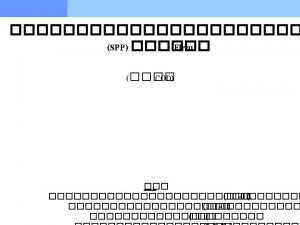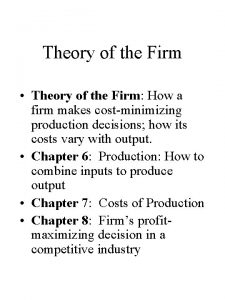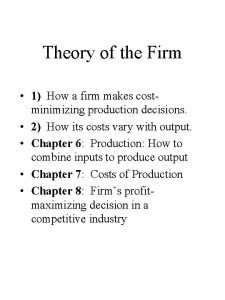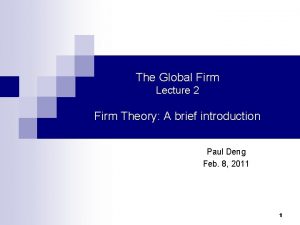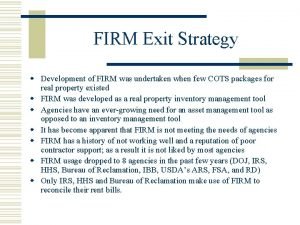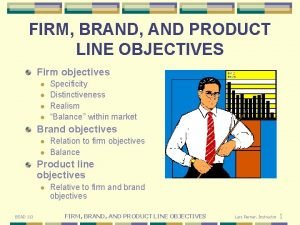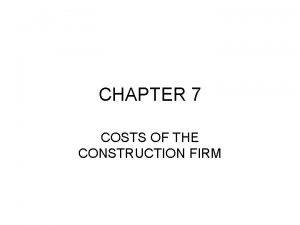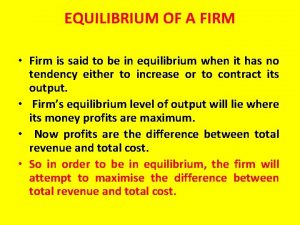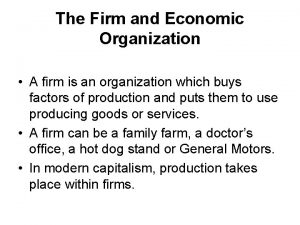Theory of the Firm 1 How a firm















- Slides: 15

Theory of the Firm • 1) How a firm makes costminimizing production decisions. • 2) How its costs vary with output. • Chapter 6: Production: How to combine inputs to produce output • Chapter 7: Costs of Production • Chapter 8: Firm’s profitmaximizing decision in a competitive industry

Chapter 6: Production • Production technology: how firms combine inputs to get output. • Inputs: also called factors of production • Production Function: math expression that shows how inputs combined to produce output. • Q = F (K, L) – Q = output – K = capital – L = labor

Production Function • Production function: Q, K, and L measured over certain time period, so all three are flows. • Production function represents: – 1) specific fixed state of technology – 2) efficient production • Short Run versus Long Run: – SR: one input is fixed. – Typically: K is fixed in the short run so can only Q by L. – LR: both inputs variable.

Production Terminology • Product: same as output • Total product of labor = TPL • As L Q , first by a lot, then less so, then Q will • Marginal product of labor: – MPL = TP/ L = Q/ L – additional output from adding one unit of L – See Table 6. 1 and Figure 6. 1 • Average product of labor: – APL = TP/L = Q/L – Output per unit of labor

To Note About Figure 6. 1 • Can derive (b) from (a). • APL at a specific amount of L: slope of line from origin to that specific point on TPL • MPL for specific amount of L: slope of line tangent to TPL at that point. • Note specific points in (a) and (b). • MPL hits APL: – 1) at the max point on APL – 2) from above.

Law of Diminishing Returns • Given existing technology, with K fixed, as keep adding one additional worker: at some point, the to TP from the one unit L will start to fall. • I. e. , MPL curve slopes upward for awhile, then slopes downward, eventually dropping below zero. • Assumes each unit of L is identical (constant quality). • Consider technological improvement: See Figure 6. 2.

Labor Productivity and Standard of Living • Labor productivity: – APL for an entire industry or for the economy as a whole. – One linkage between micro and macro. – Determines real standard of living for a country. • Background: Aggregate value of all produced = payments all factors of production, including labor. Consumers receive these factor payments in form of wages, etc. – So, consumers in aggregate can rate of consumption in LR only by total amount they produce. – How increase? • By increasing stock of K • By technological improvements. • International Trends (Table 6. 3)

Long Run • Long Run: both K and L variable • See Table 6. 4: shows different output levels associated with different amounts of K and L. • Isoquant (‘iso’ means same): curve that shows all possible combinations of inputs that yields the same output (shows flexibility in production). • Isoquant: shows how K and L can be substituted to produce same output level. – Shows input flexibility. – See Figure 6. 4.

Continue with LR • Can relate shape of isoquant to the Law of Diminishing Marginal Returns. • Marginal Rate of Technical Substitution (MRTS): – (1) Shape of isoquant. – (2) Shows amount by which K can be reduced when one extra unit of L is added, so that Q remains constant. – (3) MRTS as move down curve • Diminishing MRTS.

More on Isoquant • Isoquant curve: shows how production function permits trade-offs between K and L for fixed Q. • MRTS = - K/ L fixed Q • Isoquants are convex. • Much of this comparable to indifference curve analysis. • See Figure 6. 5.

Derive Alternative Expression for MRTS • As move down an isoquant, Q stays fixed but both K and L . • As L: additional Q from that extra L = MPL * L • As K: reduction in Q from K = MPK * - K. • These two sum to zero. • MPL* L + MPK * - K = 0. • MPL/MPK = - K/ L = MRTS. • MRTS = ratio of marginal products.


Two Special Cases of Production Functions • MRTS is a constant (I. e. , isoquant is a straight line) – Perfect substitutes • MRTS = 0: – Fixed proportion production function – Only “corner” points relevant. • See Figures 6. 6 and 6. 7.

Returns to Scale (RTS) • Long run concept: by how much does Q when inputs in proportion? • Or: if double inputs, by how much does Q change? • 1) Increasing RTS: if double inputs more than double Q – Production advantage to large firm. • 2) Constant RTS: if double inputs double Q. • 3) Decreasing RTS: if double inputs less than double Q. • See Figure 6. 9

Exercise • • Input Output L K Combo A 100 20 40 B 250 40 80 C 600 90 180 D 810 126 252 A) Calculate % in each of K, L, and Q in moving from A B, B C, and C D. • B) Are there increasing, decreasing or constant returns to scale between A and B? B and C? C and D?
 Hát kết hợp bộ gõ cơ thể
Hát kết hợp bộ gõ cơ thể Ng-html
Ng-html Bổ thể
Bổ thể Tỉ lệ cơ thể trẻ em
Tỉ lệ cơ thể trẻ em Chó sói
Chó sói Tư thế worms-breton
Tư thế worms-breton Chúa yêu trần thế
Chúa yêu trần thế Môn thể thao bắt đầu bằng chữ đua
Môn thể thao bắt đầu bằng chữ đua Thế nào là hệ số cao nhất
Thế nào là hệ số cao nhất Các châu lục và đại dương trên thế giới
Các châu lục và đại dương trên thế giới Công thức tiính động năng
Công thức tiính động năng Trời xanh đây là của chúng ta thể thơ
Trời xanh đây là của chúng ta thể thơ Mật thư tọa độ 5x5
Mật thư tọa độ 5x5 Làm thế nào để 102-1=99
Làm thế nào để 102-1=99 độ dài liên kết
độ dài liên kết Các châu lục và đại dương trên thế giới
Các châu lục và đại dương trên thế giới
















